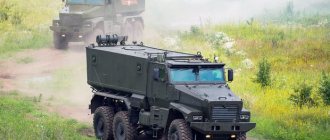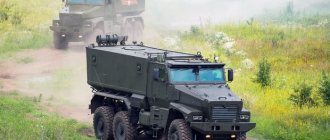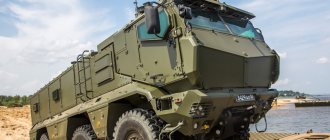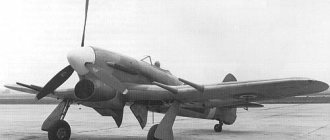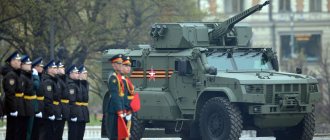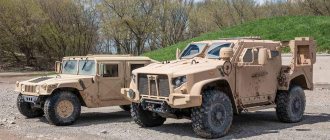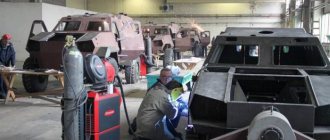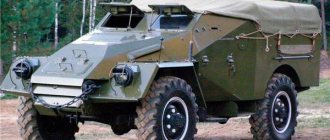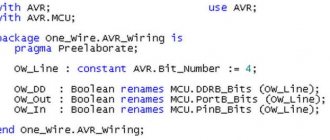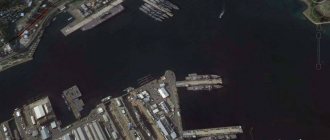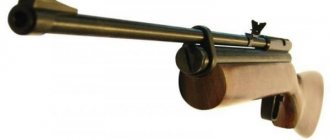Comfort and combat power
Typhoon-VDV (the original name of the model. Now usually called Typhoon-D) was presented to the public in October 2022 at the Interpolitech exhibition. The car does not give the impression of a large and oversized car, although it is many times larger than any SUV and weighs 13 tons. This was the first time I saw this model with the fire turret already installed. It looks brutal: without a 30-mm cannon, it was just a machine.
Content
- Greeted by clothes
- 5 reasons to buy the Typhoon all-terrain vehicle
- Consult and buy
Dear fishermen, are you looking for similar equipment, but the price tag on it is space? Then you absolutely need to get to know the TYPHOON all-terrain vehicle better.
This is a four-wheeled, flat-rotating tubeless all-terrain swamp vehicle, which was created specifically for fishermen and hunters who are looking for comfort and reliability, who value safety and ease of operation, but are not ready to overpay for all this!
No experience required
I especially liked the car for its solidity and ability to drive on difficult roads. Unfortunately, it is not yet known what endurance margin Typhoon-D has. And it is unclear how easy it will be to repair the Typhoon in combat conditions.
Testers say that they are “tormenting” the car around the clock: the model is still undergoing running and combat tests. Now designers are literally trying to break the car and find out the maximum load threshold so that all weak points become obvious and are eliminated at the testing stage.
Military engineers have a saying: as soon as the TV crews turn on the cameras, something goes wrong. The technique in this regard is capricious and shows character. We are used to this, we even sometimes reassure developers if something doesn’t work. There were no such problems with Typhoon. He never hesitated.
To control a combat vehicle, driving skills, oddly enough, require standard ones. I, being an ordinary driver, got behind the wheel and immediately drove off. Moreover, the armored car is quite friendly in this regard - there is even a rear view camera that helps when parking. Probably only a driving school student could encounter difficulties here. The only difficulty: if you want to dig around under the hood, it will be problematic to do so: on top of the hood there is an armored plate that cannot be lifted by one person.
There are no world analogues of such a car yet. The Typhoon's ability to land from the air is a very complex technology in itself. The car is ready to land in extreme conditions of any season, and after landing it immediately starts and drives. In addition, this vehicle has full-fledged artillery weapons on board, which greatly increases its effectiveness as a combat unit. The purpose of such equipment is to be ahead at the line of fire. Typhoon-D is an assault vehicle, and hiding is not in its nature.
Typhoon-VDV (Typhoon-D)Weight 13.5 t |
Armored car for drifting - test drive of a landing vehicle
KAMAZ "Typhoon". Universal armored personnel carrier of the MRAP class
First of all, this car attracts attention with its non-standard body shape.
It is made in the shape of a hex nut, with a V-shaped bottom. Moreover, it is equipped with composite ceramic armor, which, in combination with the non-standard shape of the bottom, makes it possible to withstand explosions of up to 8 kg of TNT equivalent. This is the KAMAZ Typhoon , presented by the plant from Naberezhnye Chelny in 2011.
The content of the article
The emergence of the Typhoon family
The history of these vehicles began in the early eighties, when the party and government instructed allied enterprises of the military-industrial complex to develop a unified line of armored trucks - heavy trucks for transporting special-purpose military units.
The center of the once secret development program, called “Garage”, included, first of all, MAZ, KAMAZ and UAZ. It was assumed that the armored trucks developed under this program would have unified, interchangeable components.
The collapse of the country put an end to “Garage”, but certain developments acquired in the late eighties were needed already in 2010, when the Russian government returned to the idea of developing and producing armored vehicles for airborne special forces. What can you do, military theory has undergone major changes, and the mobility and security of specially trained and armed professional groups is given great importance.
Special vehicles for special forces
The Americans, for example, have long been producing so-called MRAPs - special vehicles with a high degree of armor protection for their special forces. Russian special forces have also adopted a similar approach. KAMAZ "Typhoon" is the first serious attempt to take steps in this direction.
It is planned that, based on several platforms being developed, a whole line of military vehicles will be produced - the Typhoon , for various purposes, with various configurations and various equipment.
Technology on the verge of fantasy
KAMAZ "Typhoon" is planned to be produced in two versions - with a modular and hull body and with a central engine location. The YaMZ-5367 engine with a volume of seven thousand cubic centimeters in combination with a proprietary turbocharger produces a power of four hundred and fifty horsepower, while consuming only thirty-five liters of diesel fuel per hundred.
The number of personnel seats in the Typhoon is provided (depending on the type of body): nineteen - in the hull type and thirteen - in the modular one. A six-speed gearbox coupled with independent suspensions on each of the six drive wheels gives the KAMAZ 63968 “Typhoon” increased cross-country ability, and the automatic tire inflation system, adjustable from the driver’s cabin, will help not only in case of damage to the wheels of the armored car, but also when overcoming difficult areas. How can one not recall the legendary ZIL-157 in which this system was tested for the first time.
The main thing is protection
But the main thing in the Typhoon is the technology of armoring and increasing the survivability of the vehicle. Ceramic armor developed by specialists from the Steel Institute is able to withstand a bullet fired from a Vladimirov heavy machine gun (KPV) with a caliber of fourteen and a half millimeters from a distance of two hundred meters - a very, very decent result. Moreover, the ceramic armor used on Typhoons is much lighter than similar armor steel.
But it was not possible to equip the Typhoon with armored glass right away, and this procedure was quite difficult due to problems with suppliers. A square meter of armored glass developed for the Typhoon weighs three hundred kilograms. Not the best indicator, but it “holds” the same bullet against KPVT.
Even more impressive is the mine protection that the armored car is equipped with. In accordance with the requirements of the Ministry of Defense, the vehicle can withstand an 8kg IED explosion. in TNT equivalent with the possibility of continuing movement.
Competing technology
, KAMAZ 63968 “Typhoon” was presented to the attention of the public And the tests, judging by the reviews, made a good impression on the military. In any case, about a year later, the Russian army abandoned the idea of purchasing a large batch of armored “Iveco” designed to perform the same function of MRAP, each costing about four hundred and fifty thousand euros (including weapons and special equipment).
Moreover, it is perhaps worth mentioning that the Typhoon was planned for production not only by KAMAZ (the classic cabover), but also by the Ulyanovsk Automobile Plant. They claim that the Urals - Typhoon are sufficiently unified with KAMAZ, and they have enough interchangeable components and assemblies.
In various guises
“Typhoon” is intended to be produced in various versions, ranging from equipment performing auxiliary functions (fire engines, minesweepers and sapper “search engines”, pontoon carriers and evacuation tractors) to the most combat-ready ones - the rapid transfer of special forces troops with the provision of anti-mine and shooting protection.
Moreover, at a fairly high speed, for such a weight, of one hundred kilometers per hour on hard surfaces.
In addition, models and modifications of the Typhoon are provided that will serve as mobile launch platforms for anti-aircraft missile systems and mobile artillery systems. There are projects on which it is planned to install S-400 anti-aircraft missile systems.
At the moment, the list of Typhoon created by KAMAZ looks like this:
- KAMAZ-5388 - a 4x4 chassis designed for mounting an onboard body, cranes, multi-lifts and other military equipment that does not require special protection;
- KAMAZ-53888 modification based on the same 5388, but with installed armor;
- KAMAZ-6396 is a three-axle chassis not intended for installation of armor protection;
- KAMAZ-63968 - armored version of the KAMAZ-6396 modification;
- KAMAZ-6398 - four-axle version of KAMAZ-6396 without armor;
- KAMAZ-63988 - armored version of "6398".
Modern technologies
And, perhaps, the most important of the technical innovations used on the Typhoon is the complex on-board information and control system (BIUS), which collects and analyzes information from a variety of sensors installed on all the main components and assemblies of the car and develops optimal options for settings and adjustments of running coefficients.
The BIUS receives data from the parametric equipment about the angles of inclination and condition of the road, determines the modes of the greatest efficiency of the suspension and ground clearance adjustment.
In fact, quite a lot of information on Typhoon is not disclosed either in the press or in official published documentation. Most likely, some part of the parameters of the armored car is still at the development stage, and final passport data simply still does not exist.
After all, let’s not forget that there is practically no modern experience and developments in mine protection for serial military vehicles in the Russian military-industrial complex. Everything has to be either adopted or developed from scratch.
Tactical secrets
One thing can be said with certainty - modern methods of conducting combat operations involve the use of tactics of high mobility of groups of special forces. When it is necessary to transfer a group of paratroopers as quickly as possible - that is, there is usually not enough time to reconnoiter access roads and, therefore, there is a high risk of running into an ambush or mined sections of the road.
This is precisely why the troops need armored vehicles with the highest possible level of armor protection for both the bottom and the sides and passenger compartments. The combat experience of Afghanistan, Iraq, and the North Caucasus, when they effectively fought against personnel units using homemade devices due to the low efficiency of inherited Soviet equipment, is proof of this.
What's the result?
According to the designers, there are almost no serial elements in the cars; everything was developed and fine-tuned “from scratch” and let’s hope that Kama engineers will decide to apply the most successful solutions to civilian vehicles.
It is not for nothing that attempts to create a unified vehicle platform for troops have been made since Soviet times. How effective this is in economic terms, I think, is not even worth talking about. Let us wish the KAMAZ “Typhoons” good luck.
Source
Armored vehicle KAMAZ-63968 Typhoon-K TTX, Video, Photo
KAMAZ-63968 "Typhoon-K" with a Remotely Controlled Combat Module
KAMAZ-63968 "Typhoon-K" is a universal armored vehicle with increased security on the original chassis. Compatible with MRAP type vehicles. It is part of the Typhoon family of armored vehicles. The armored vehicle was created after the approval of the Concept for the development of military vehicles of the Armed Forces of the Russian Federation for the period until 2022, which outlines the production of vehicles based on unified families.
